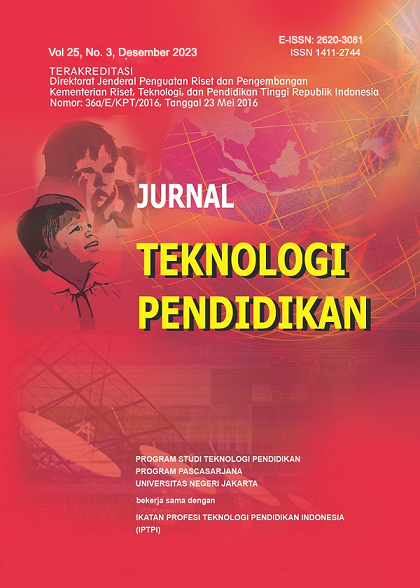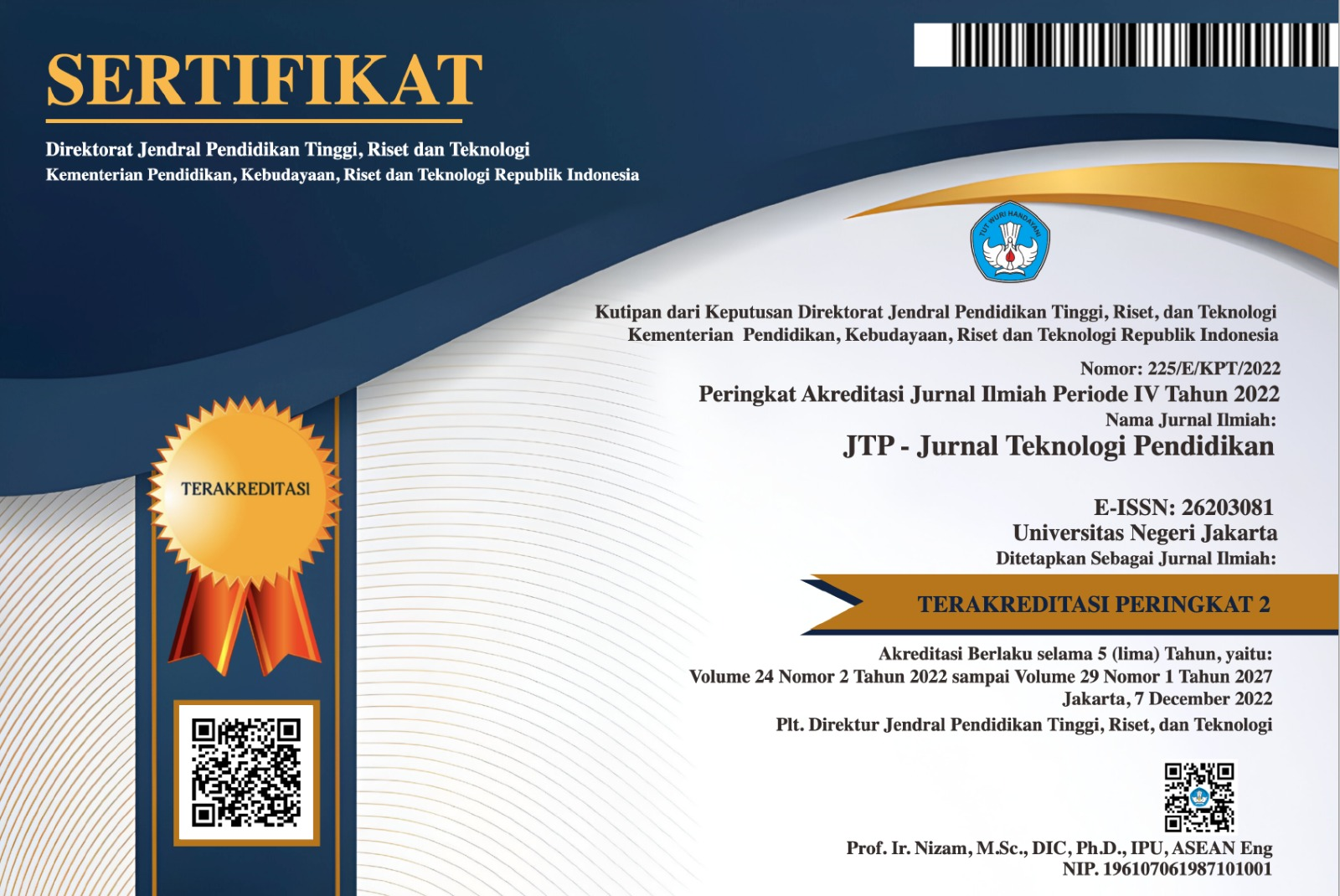E-Portfolio for Distance Learning in Elementary School
DOI:
https://doi.org/10.21009/jtp.v25i3.38870Keywords:
e-portfolio, distance learning, elementary schoolAbstract
Technology is being a part of education development. Every sector use a digital tool to assist their work. The purpose of this study was to determine the effectiveness of distance learning e-portfolios. This research uses mixed methods by combining qualitative and quantitative research methods to be used together in research activity to obtain more comprehensive, valid, reliable, and objective data. The data collected used by collecting and analyzing qualitative data built on quantitative preliminary results to analyze web-based e-portfolios on distance learning in elementary schools. The result of this study state that using e-portfolio assessment wisely to balance classroom assessment and facilitate content knowledge learning is an alternative for teachers. Using a web-based portfolio can minimize the space as a place to store tasks with more diverse formats. Storage can also be neater, making it easy to find and easier to assess by educators.
References
Alajmi, M. M. (2019). The impact of E-portfolio use on the development of professional standards and life skills of students: A case study. Entrepreneurship and Sustainability Issues, 6(4), 1714–1735. https://doi.org/10.9770/jesi.2019.6.4(12)
Balaban, I. (2020). An empirical evaluation of E-Portfolio critical success factors. International Journal of Emerging Technologies in Learning, 15(4), 37–52. https://doi.org/10.3991/ijet.v15i04.11757
Barrot, J. S. (2020). Effects of Facebook-based e-portfolio on ESL learners’ writing performance. Language, Culture and Curriculum, 34(1), 95–111. https://doi.org/10.1080/07908318.2020.1745822
Beckers, J., Dolmans, D. H. J. M., Knapen, M. M. H., & van Merriënboer, J. J. G. (2019). Walking the tightrope with an e-portfolio: imbalance between support and autonomy hampers self-directed learning. Journal of Vocational Education and Training, 71(2), 260–288. https://doi.org/10.1080/13636820.2018.1481448
Bowen, P., Rose, R., & Pilkington, A. (2017). Mixed methods- theory and practice. sequential, explanatory approach. International Journal of Quantitative and Qualitative Research Methods, 5(2).
Bubb, S., & Jones, M. A. (2020). Learning from the COVID-19 home-schooling experience: Listening to pupils, parents/carers and teachers. Improving Schools, 23(3), 209–222. https://doi.org/10.1177/1365480220958797
Cepik, S., & Yastibas, A. E. (2013). The use of e-portfolio to improve English speaking skill of Turkish EFL learners. Anthropologist, 16(1–2), 307–317. https://doi.org/10.1080/09720073.2013.11891358
Chang, C. C., Liang, C., Chou, P. N., & Liao, Y. M. (2018). Using e-portfolio for learning goal setting to facilitate self-regulated learning of high school students. Behaviour and Information Technology, 37(12), 1237–1251. https://doi.org/10.1080/0144929X.2018.1496275
Chiu, T. K. F. (2021). Digital support for student engagement in blended learning based on self-determination theory. Computers in Human Behavior, 124. https://doi.org/10.1016/j.chb.2021.106909
Dixon, W. M., Agarwal, S., Jones, D., Young, B., & Sutton, A. (2005). synthesising qualitative and quantitative evidence: A review of possible methods. Journal of Health Services Research & Policy, 10(1), 45–55.
Gámiz-Sánchez, V., Gutiérrez-Santiuste, E., & Hinojosa-Pareja, E. (2019). Influence of Professors on Student Satisfaction With e-Portfolio Use. Journal of Educational Computing Research, 57(3), 646–669. https://doi.org/10.1177/0735633118757016
Greviana, N., Mustika, R., & Soemantri, D. (2020). Development of e‐portfolio in undergraduate clinical dentistry: How trainees select and reflect on evidence. European Journal of Dental Education, 24(2), 320–327. https://doi.org/10.1111/eje.12502
Händel, M., Wimmer, B., & Ziegler, A. (2020). E-portfolio use and its effects on exam performance – a field study. Studies in Higher Education, 45(2), 258–270. https://doi.org/10.1080/03075079.2018.1510388
Hooker, T. (2019). Using ePortfolios in early childhood education: Recalling, reconnecting, restarting and learning. Journal of Early Childhood Research, 17(4), 376–391. https://doi.org/10.1177/1476718X19875778
Hung, S. T. A. (2012). A washback study on e-portfolio assessment in an English as a Foreign Language teacher preparation program. Computer Assisted Language Learning, 25(1), 21–36. https://doi.org/10.1080/09588221.2010.551756
Kilinc, E., Kilinc, S., Kaya, M. M., Baser, E. H., Turkuresin, H. E., & Kesten, A. (2016). Teachers’ attitudes toward the use of technology in social studies teaching. Research in Social Sciences and Technology, 1(1), 59–76. http://dx.doi.org/10.1016/j.cirp.2016.06.001%0Ahttp://dx.doi.org/10.1016/j.powtec.2016.12.055%0Ahttps://doi.org/10.1016/j.ijfatigue.2019.02.006%0Ahttps://doi.org/10.1016/j.matlet.2019.04.024%0Ahttps://doi.org/10.1016/j.matlet.2019.127252%0Ahttp://dx.doi.o
Lam, R., & Lee, I. (2009). Balancing the dual functions of portfolio assessment. ELT Journal, 64(1), 54–64. https://doi.org/10.1093/elt/ccp024
Lukitasari, M., Handhika, J., & Murtafiah, W. (2018). Higher order thinking skills : using e-portfolio in project-based learning. IOP Conf. Series: Journal of Physics.
Moorhouse, B. L. (2019). Seesaw: https://web.seesaw.me. RELC Journal, 50(3), 493–496. https://doi.org/10.1177/0033688218781976
Nur, M. R. O., & Riadil, I. G. (2019). Digital Natives’ Preference in 4.0 Speaking Learning Class. DIGITAL NATIVES, 3, 7.
Oner, D., & Adadan, E. (2011). Use of web-based portfolios as tools for reflection in preservice teacher education. Journal of Teacher Education, 62(5), 477–492. https://doi.org/10.1177/0022487111416123
Papadakis, S., & Kalogiannakis, M. (2017). Mobile educational applications for children. What educators and parents need to know. International Journal of Mobile Learning and Organisation, 11(2), 1. https://doi.org/10.1504/ijmlo.2017.10003925
Riadil, I. G. (2020). Teaching English: An afresh sophisticated technique to cultivate digital native learners’ vocabulary by utilizing seesaw media as digital literacy. Journal of Research on English and Language Learning (J-REaLL), 1(2), 62. https://doi.org/10.33474/j-reall.v1i2.6855
Sharifi, M., Soleimani, H., & Jafarigohar, M. (2017). E-portfolio evaluation and vocabulary learning: Moving from pedagogy to andragogy. British Journal of Educational Technology, 48(6), 1441–1450. https://doi.org/10.1111/bjet.12479
Shea, T., & Parayitam, S. (2019). Antecedents of graduate student satisfaction through e-portfolio: content analysis. Education and Training, 61(9), 1045–1063. https://doi.org/10.1108/ET-04-2019-0064
Sidebotham, M., Baird, K., Walters, C., & Gamble, J. (2018). Preparing student midwives for professional practice: Evaluation of a student e-portfolio assessment item. Nurse Education in Practice, 32(April), 84–89. https://doi.org/10.1016/j.nepr.2018.07.008
Sidhu, N. S. (2015). The teaching portfolio as a professional development tool for anaesthetists. Anaesthesia and Intensive Care, 43(3), 328–334. https://doi.org/10.1177/0310057x1504300308
Swart, A. J. (2015). Student usage of a learning management system at an open distance learning institute: A case study in electrical engineering. International Journal of Electrical Engineering Education, 52(2), 142–154. https://doi.org/10.1177/0020720915575925
Theodosiadou, D., & Konstantinidis, A. (2015). Introducing e-portfolio use to primary school pupils: Response, benefits and challenges. Journal of Information Technology Education: Innovations in Practice, 14(1), 17–38. https://doi.org/10.28945/2158
Thornton, L., Ferris, N., Johnson, G., Kidwai, K., & Ching, Y. H. (2011). The Impact of an E-Portfolio Program in a Music Education Curriculum. Journal of Music Teacher Education, 21(1), 65–77. https://doi.org/10.1177/1057083710397592
van der Schaaf, M., Donkers, J., Slof, B., Moonen-van Loon, J., van Tartwijk, J., Driessen, E., Badii, A., Serban, O., & Ten Cate, O. (2017). Improving workplace-based assessment and feedback by an E-portfolio enhanced with learning analytics. Educational Technology Research and Development, 65(2), 359–380. https://doi.org/10.1007/s11423-016-9496-8
van Wyk, M. M. (2017). An e-portfolio as empowering tool to enhance students’ self-directed learning in a teacher education course: A case of a South African university. South African Journal of Higher Education, 31(3). https://doi.org/10.20853/31-3-834
Vattøy, K. D., & Gamlem, S. M. (2019). Systematic observation with two analytic video-score approaches and loss of instructional time in lessons. Cogent Education, 6(1). https://doi.org/10.1080/2331186X.2019.1664841
Venville, A., Cleak, H., & Bould, E. (2017). Exploring the Potential of a Collaborative Web-based E-portfolio in Social Work Field Education. Australian Social Work, 70(2), 185–196. https://doi.org/10.1080/0312407X.2017.1278735
Yin, R. K. (2011). Qualitative Research From Start to Finish. The Guilford Press.
Downloads
Published
How to Cite
Issue
Section
License
Jurnal Teknologi Pendidikan is an Open Access Journal. The authors who publish the manuscript in Jurnal Teknologi Pendidikan agree to the following terms.
Attribution-ShareAlike 4.0 International (CC BY-SA 4.0)
-
Attribution — You must give appropriate credit, provide a link to the license, and indicate if changes were made. You may do so in any reasonable manner, but not in any way that suggests the licensor endorses you or your use.
-
ShareAlike — If you remix, transform, or build upon the material, you must distribute your contributions under the same license as the original.
- No additional restrictions — You may not apply legal terms or technological measures that legally restrict others from doing anything the license permits.
Notices:
- You do not have to comply with the license for elements of the material in the public domain or where your use is permitted by an applicable exception or limitation.
- No warranties are given. The license may not give you all of the permissions necessary for your intended use. For example, other rights such as publicity, privacy, or moral rights may limit how you use the material.








